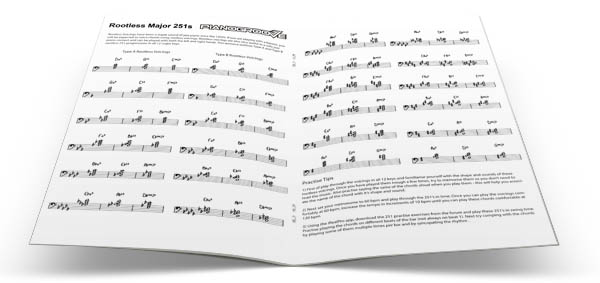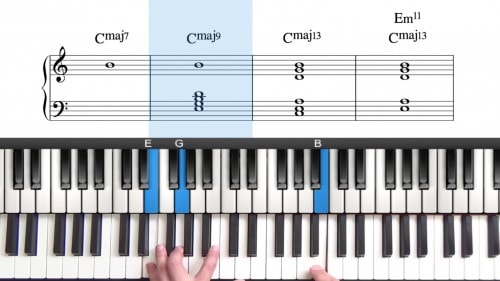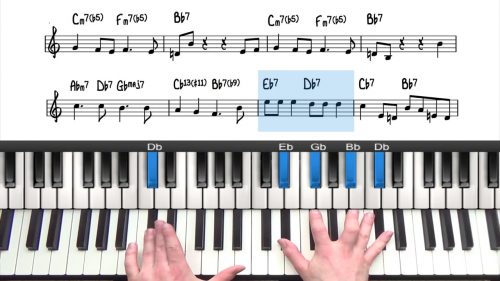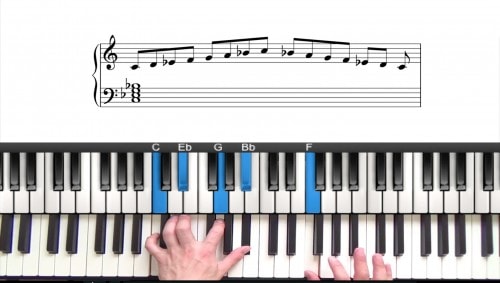Rootless Voicings Tutorial
Rootless voicings are also known as left hand voicings or Bill Evans voicings so be aware that these three terms refer to the same thing. In this lesson we are going to cover what a voicing is, what makes it rootless, and why we use rootless voicings.
Downloadable Lesson Supplement
Download this free PDF containing rootless 251 progressions in all 12 keys:

What Are Rootless Chord Voicings?
Rootless voicings are an essential skill for the modern jazz pianist. To play a rootless voicing, we leave out the root of the chord and play one of the chord extensions instead so for example we could play the 3rd , 5th , 7th and the 9th could be the additional extension of the chord.
Rootless voicings achieve very smooth voice leading in the context of a rootless 251 progression. This reduces hand movement and will make your playing sound much more professional and sophisticated than root based voicings.
Rootless voicings are also useful in a solo piano context and are a great voicing choice to support soloing and improvisation in your right hand.
How Do We Play Rootless Chord Voicings?
A voicing is the way that we choose to spread out or arrange the notes of a chord on the keyboard. We learnt in the lesson on chord extensions that we can extend the chord past the octave to play the 9th, 11th and 13th .
To play a rootless voicing, we leave out the root of the chord and play one of the extensions instead so for example we could play the 3rd , 5th , 7th and 9th of the chord.
Why Do We Use Rootless Voicings?
Rootless voicings achieve very smooth voice leading in a 251 progression which has 2 main benefits:
-
The first is that the chords will flow from one to the next very smoothly which sounds great to the listener!
- The second is that it reduces hand movement to a minimum so that you can move from one chord to the next very easily and focus you attention on soloing in your right hand.
Rootless voicings free up a finger for more interesting and colourful note choices such as a 9th, 11th or 13th which makes your playing sound more professional.
If you are playing in a jazz band, the bass player will have the root of the chord covered so there is no need for you to play it.
Rootless Voicings For Major Chords
To turn a major chord into a rootless voicing, we add the 9th and then drop the root. The alternative way to build a rootless voicing for major chords is to build a minor 7th chord off the major 3rd . In the key of C you would build a minor 7th chord of E which is the third.
Rootless Voicings For Minor Chords
We build minor rootless voicings in the same way as with major chords, we add the 9 and we drop the root. Remember that both major and minor chords share the same 9th. The alternative way to build a rootless voicing for minor chords is to go to the minor 3rd and build a major 7th chord. In the key of C minor we build a major 7th chord of Eb which is the minor 3rd.
How To Invert Rootless Voicings
There are two important inversions that you need to learn for rootless voicings: Type A and Type B.
-
The formula for Type A rootless voicings is 3-5-7-9
- The formula for Type B rootless voicings is 7-9-3-5
Type A rootless voicings always have the 3rd on the bottom and Type B always have the 7th on the bottom. An easy way to get from Type A to Type B is to take the bottom two notes and put them on the top (or take the top two notes and put them on the bottom).
Why Invert Rootless Voicings?
You might be wondering why we invert rootless voicings and the answer is so that we can play them in the correct register of the piano. Rootless voicings sound best when played right in the centre of the piano (around middle C). If you play rootless voicings too low on the keyboard they will sound ‘muddy’ and distorted. If you play them too high they will sound very ‘thin’.
By inverting rootless voicings you can always play them on or close to the centre of the piano to get the best sound.
Rootless Voicings For Dominant Chords
Rootless dominant 7th voicings are a bit trickier than major and minor chords. We could voice them in the same way that we have voiced the major and minor chords. However, this would not voice lead smoothly in the context of a 251 progression.
Instead we substitute the 5th for the 13th. This creates tension and dissonance between the 13th and then b7th.
Lesson Downloads
-
Rootless Major 251 Progressions – 12 Keys File Type: pdf
Practice Tips
-
You should practice rootless voicings most times you sit down to practice until you can play them in all 12 keys without mistakes.
-
Play the root of the chord in your left hand and then a rootless voicing in your right hand. Take this around the circle of fifth, then move up and down chromatically, then choose keys at random to test yourself.
-
Make sure you are analysing the notes you are playing and identifying the chord tones and extensions in relation to the underlying bass note.
-
Once you are comfortable with this, drop the root and play the rootless voicings with just your left hand. Repeat the above exercises.
-
It can be a challenge at first to visualise the chords without the root so stick with it!
- The next step is to combine these chords into the rootless 251 progression.








I’m just starting to dive into this topic
And I’m very excited about it
Thanks for sharing!
Greetings from Cancun Mexico
Hey Daniel, that’s awesome… I hope you enjoy the lesson!
If I can help you with anything just let me know :-)
Cheers,
Hayden
Hey Hayden, at 7:45 following, why are you calling them 7th chords, instead of 9th chords? Jessica
Hi Jessica… good question!
You need to understand that jazz musicians will refer to chords as ‘7’ even when it contains other extensions and alterations. Think of this as shorthand. So if I was playing a C minor 11 chord, and a jazz musician asked me what chord i was playing, i could just say Cm7.
In the same way, if you see ‘7’ on a lead sheet, this does not mean that you are just restricted to the 7th, in fact, this will often sound plain and so you have the creative freedom to add in additional extension/alterations as you see and hear fit.
In some cases, you will see a very specific chord symbol, such as Cmaj13#11, in this case I would first try those specific alterations/extensions as they will either sound best, or be more inline with the composers original intentions.
I hope this helps Jessica and if you would like me to elaborate on anything, just let me know :-)
Cheers,
Hayden
Great video, thorough but not too slow! Can’t believe I never saw this before!
Greetings from Sweden.
Thanks Simon, I’m glad you found the lesson useful!
Cheers, Hayden
This is the first video I’ve watched – I’m impressed! And will definitely be looking at more material on the site.
The only point I’d make is that sometimes ‘incorrect’ enharmonic equivalents are shown. For example when discussing the DMaj7 chords at around 5:15 the notes shown are D Gb A Db, when they should be D F# A C#. I know they sound the same, but when it comes to discussing how the third and seventh are the definiting notes of the chord, it’s important to recognise them as such.
Anyway, it’s just a small point and doesn’t detract from the video being wonderful, but something you might want to take note of in the future…
Thanks Sarah, great to hear you found the lesson useful.
Yes my apologies for the enharmonic equivalents, most jazz standards are written in flat keys so I opted to go for all flats for the black keys. In hindsight I should have chosen to mix sharps and flats for theory lessons like this where we are going though many different keys.
As you say it’s good to be able to recognise these enharmonic equivalents but I agree it can be confusing. I will make note and change this for future lessons.
If I can help you with anything you are working on, feel free to comment or send me an email.
Cheers,
Hayden
thank you soooo much this is exactly what i needed
Hi Damon, my pleasure… I’m glad you enjoyed the lesson. Check out the jazz standard lessons in this course where we apply the voicings in context. Cheers, Hayden
Can’t seem to play the videos since the website update.
HI Adam,
Thanks for making me aware of this. Please can you try the following:
1) Try a different browser
2) Try a different device
–> This will help us identify whether it is specific to the computer or device you are using.
If it is, then try clearing your cache and your history. Sometimes your browser may be storing an older version of the site which is causing playback issues.
I have also emailed you so reply to me whichever way is most convenient for you :-)
Cheers,
Hayden
When using the Safari browser I am having issues. Probably my flash player. I am fine watching videos using Chrome. Thanks again for your concern.
No problem Adam… thanks for letting me know about this, I will investigate further. Cheers :-)
Very helpful. Well-paced too. Thank you.
Thanks Troy… glad you liked the tutorial :-)
You stated that it is good to use rootless voicing so that you stay out of the way of the bass player. I don’t intend to play in a band. So would I have to play the tonic note in the melody somewhere. Thanks.
Hey apologies for the late reply… I was not notified of this comment.
If you are playing solo jazz piano, then yes, you would want to include the root in your voicings most of the time.
That being said, it’s nice to sprinkle in rootless voicings here and there to add different textures to your arrangement. Another application could be if you are playing a left hand stride style…. a nice effect is to hit the root way down in the lower registers and then come with your left hand to play rootless voicings.
There are a number of key reasons why we play rootless voicings, and why learning them is an important part of your musical development:
1) You free up a finger for a more interesting note choice such as an extension or alteration
2) Rootless voicings voice lead much more smoothly in a 251- it’s easy to play a rootless 251 without looking and so you can focus on your right hand lines.
3) You will become familiar with extensions and alterations, if you don’t practice rootless voicings, chances are you will be sticking to simple root position 7th chords. Practicing rootless voicings will give you a much greater appreciation of the extended and altered tones available to you.
I hope this helps you understand some different applications of rootless voicings. You should really spend the time to learn them!
Cheers,
Hayden
Sometimes I find a message in this lesson saying “html5: Video not properly encoded” !
Thanks for letting me know Anthony… I have just updated the video software which should fix the issue.
Please try logging out and back in again, and let me know if the issue persists.
Cheers,
Hayden
🔥🙌🏾😎💫 Brilliant, concise and easy to follow explanation. Bravo 👏🏾
Thanks glad you enjoyed the lesson. Cheers, Hayden
I continue to get a freeze w/ 4 centered vertical lines moving up&down…not possible to undue and must close. Rootless voicing froze @ 8:55..happens frequently. Does anyone else have the problem?
so type A and type B is basically open and close position with left hand right?
Hi Jacobs.
I’m unsure on your exact question here, but I can try to explain the key points:
– type A and type B contain the same notes, but in different orders
– type A is 3-5-7-9
– type B is 7-9-3-5
– rootless voicings sound best when played around middle C, with the 2 positions (type A & B) we can always play our voicings in this register of the piano
– there are other inversions, but the ones covered in this lesson are the most practical and useful to have ‘under our fingers’
– Initially, focus on the numbers, try to visualise each scale degree when playing the voicings. I find it easy to see either the 3 or 7 on the bottom, and then it’s easy to visualise the rest of the chord
– Eventually these voicings will become second nature when you see the chord symbol and our muscle memory does all of the work
– Learning them in all 12 keys is a gradual process that can take multiple years. Progress onto other theory topics in the PianoGroove syllabus but revisit the drills and exercises in the practice series of this course
Hope this helps! :-)
Hayden
Hey Hayden!
I’ve been chiselling away at these voicings for weeks. They’re pretty great – thank you!
When I’ve tried arranging with them though, I run into two problems. The first is that sometimes the melody will collide with the chord. The second is that I’m just playing the chord on the 1 and the 3, without much variation. What would you recommend?
Thank you!
Hi Theo,
Yes that’s exactly how to learn rootless theory, it is a big subject and so we must chip away at the task each day. You will find that with practice, these voicings become second nature so when we see the chord symbol on the lead sheet, our hands naturally gravitate to the different rootless shapes:
Yes it is natural for the melody to collide as rootless voicings sounds best right around middle C and this is also a common range for the melody. We have 3 options here:
1) The easiest option is to move the melody up an octave, or even 2 octaves. It’s also good practice to play in the higher registers of the piano as we have all those notes at our disposal, so just because the melody of a jazz standard is written around middle C, it doesn’t mean that we must keep it in that octave.
2) The second option is to change the melody by taking notes away or rephrasing it so that we can avoid the collision.
3) The final option is just to play a fragment of the rootless voicing. This works well if we are playing a stride style because we have already established the root of the chord and so we can sometimes just play little ‘clusters’ of notes from the scale, or even just one note. Check out this lesson on cluster voicings for some ideas: pianogroove.com/jazz-piano-lessons/cluster-voicings/
To answer your other question about playing on the 1 and 3. The best thing to do here is listen to some of the great jazz players and how they comp. If you are playing at a medium tempo with a swing feel, check out Wynton Kelly and Red Garland who had brilliant comping rhythms in their left hand, you can find 2 studies here:
pianogroove.com/community/t/red-garland-transcription-exercises/4101
pianogroove.com/community/t/wynton-kelly-transcription-exercises/3810
You might also be interested in the “locked hands” technique where the rootless voicings play the same rhythm as the melody, here is one of my tutorials on this style:
pianogroove.com/jazz-piano-lessons/locked-hands-improvisation/
That lesson is part 3 of a 3-part study on the tune “Alone Together” – here are parts 1 & 2:
pianogroove.com/jazz-piano-lessons/alone-together-left-hand-voicings/
pianogroove.com/jazz-piano-lessons/approach-patterns-target-notes/
I hope this helps Theo.
Cheers!
Hayden
Still looking for pdf Rootless -2-5-1 Minor
Hi Hayden, in the practice part towards the end of the video, is there a specific reason why we are going around the 4ths, instead of the circle of 5ths? Thanks!
Hi Dilara,
No there is no specific reason and we can work both ways around the circle.
Also check out this course on Whole Step 251 Drills: pianogroove.com/jazz-piano-lessons/whole-step-251-exercises/
This is another fun way to work through all 12 keys and it’s nice to do this alongside working with the circle of fifths.
Let me know if you have any other questions here.
You can find January’s live seminars here which have just been added to the website:
pianogroove.com/live-seminars/
community.pianogroove.com/t/january-live-seminars-topics-add-to-calendar/7681
See you in the seminars and Happy New Year to you Dilara :-)
Cheers,
Hayden
This may be obvious to others, but I find it fascinating that the rootless voicing for a major chord is the root minor chord of the third; and the rootless voicing for a minor chord is the root major chord of the third. Curious if this is an example of some deeper relationship between these chords.
Hi Gilbert,
Yes there are some interesting implications of this relationship. I hosted a seminar on the tune “Moonlight In Vermont” by Beegie Adair, and check out the 6th chapter “Beegie Adair Solo Piano Introduction” where we analyse her solo piano introduction:
pianogroove.com/live-seminars/moonlight-in-vermont-beegie-adair/
If we take the diatonic 7th chords of any major scale, the Imaj7 and iii-7 chord share many of the same tones, for example, Cmaj9 contains an entire E-7 chord (3-5-7-9) and so we can use this relationship to string together longer diatonic chord progressions – as we explore in the seminar chapter mentioned above.
Check out that seminar and I think you will find that an interesting point of study.
Cheers,
Hayden
This has been a really interesting lesson. I’d been playing around trying to understand Red Garland’s opening chords on Bye Bye Blackbird (from the album, ‘Round About Midnight) and suddenly realized, “Oh, this is just rootless voicings in the right hand.” That led me to a new exercise of playing RH type A rootless voicing progressions a la Red Garland in various keys. Very cool.
Hi Gilbert,
Yes that’s exactly right.
If you are a fan of Red Garland, check out this lesson pianogroove.com/jazz-piano-lessons/red-garland-voicing-block-chord-tutorial/
and also in the comments of that lesson you can find some other resources, this one in particular: ethaniverson.com/reds-bells/
Have fun playing around with this stuff!
Cheers,
Hayden
Bearing in mind that Type A & Type B are used to distinguish between rootless voicings built on the 3rd or the 7th, I wondered if perhaps a footnote might be added to the pdf listing what are described as Type A and Type B 251’s, pointing out that in the Type A list the 5 chords throughout are in fact Type B dominant rootless voicings, the reverse being the case in the Type B list.
Hello Hayden, I subscribed to the course because I found it very educational, but my English is not good, in fact I have to use Google Translate in each video and stop continuously to understand, it will be possible that later they include Spanish subtitles in all the videos? It will be very helpful, for now I’m just practicing my 12 scales and the first jazz standards, slowly but surely.